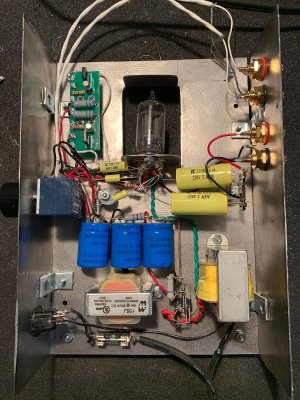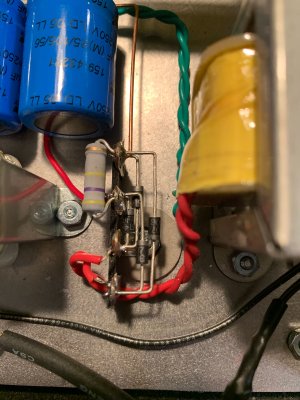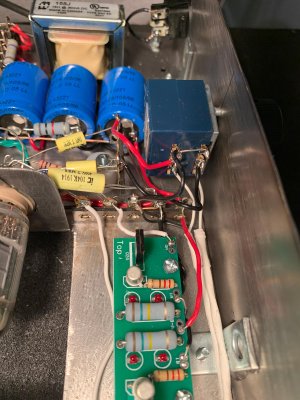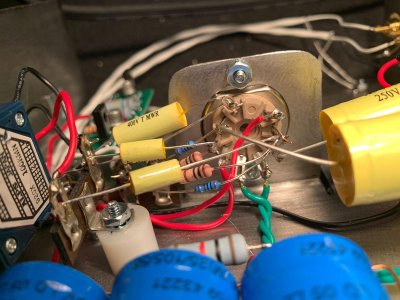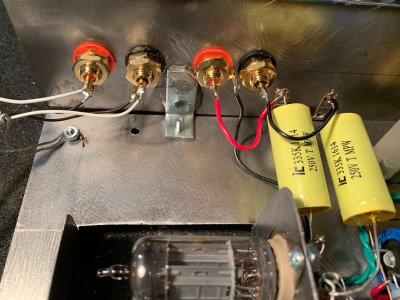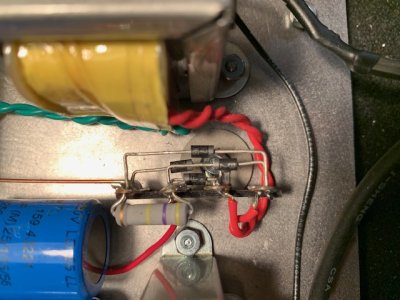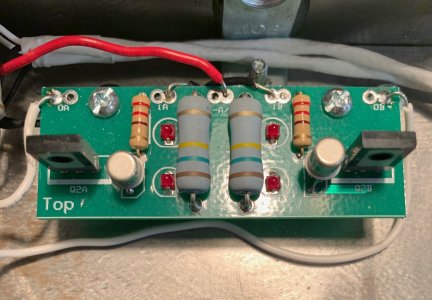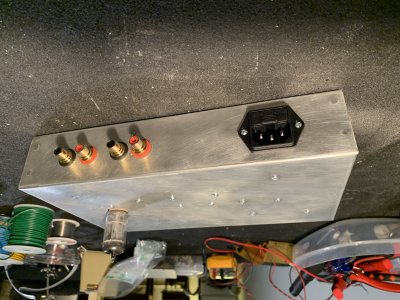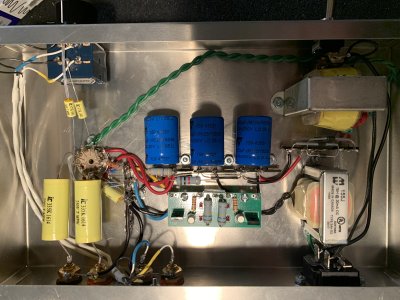Over the past month I've been ordering parts for the buffer preamp and trying to figure out how to lay it out. Today I managed to finally get the first pass built to a point where I could power it up slowly and take some voltage readings. Pics are attached for reference. So far it's just a chassis plate with front and back pieces to hold the input/outputs and volume . Not sure where it's going to end up, looks-wise.
B+ is at 115v with 120v supply. Grids are at 2.18v and cathodes are at 5.8v. Both sets of LEDs on the board fire up.
Right now I have two problems: There's no sound in one (red) channel and the PT is running very hot. The sound out of the channel that's working is pretty good, so that's encouraging at least.
I haven't been able to find any obvious bad connections in the red channel, the input isn't shorted to ground... I'll just have to keep experimenting with that one.
The overheating PT is what I could use suggestions on. The amp is pulling 240mA, and if I'm reading the AES sheet right the max rating for this PT-442 is 315mA so that should be enough headroom. What other readings could I take that might point me in the right direction?
As far as the layout goes, I wanted to try something with the tube horizontal for a lower profile, inputs and outputs on the back, volume knob on the front. Beyond that, I did my best. I was limited to 6" depth because of the steel I could find was a 6" x 18" sheet of 22ga. Seemed to make sense to have the tube in the center with the socked facing inwards for best access to the terminals, and then things just sort of filled in from there. The ground scheme is: Inputs/volume pot/chassis --> CF boards/heater center tap/outputs --> PS Caps --> DC supply negative. It's pretty compact I guess, but too cramped around the terminal strip (that holds all the connections to the B+, two ground lugs, and CF boards and cathodes/grids) and the volume pot. I appreciate any feedback if anything looks way weird or is a no-no. First try at a layout so I expect there'll be a lot to learn from mistakes here.
B+ is at 115v with 120v supply. Grids are at 2.18v and cathodes are at 5.8v. Both sets of LEDs on the board fire up.
Right now I have two problems: There's no sound in one (red) channel and the PT is running very hot. The sound out of the channel that's working is pretty good, so that's encouraging at least.
I haven't been able to find any obvious bad connections in the red channel, the input isn't shorted to ground... I'll just have to keep experimenting with that one.
The overheating PT is what I could use suggestions on. The amp is pulling 240mA, and if I'm reading the AES sheet right the max rating for this PT-442 is 315mA so that should be enough headroom. What other readings could I take that might point me in the right direction?
As far as the layout goes, I wanted to try something with the tube horizontal for a lower profile, inputs and outputs on the back, volume knob on the front. Beyond that, I did my best. I was limited to 6" depth because of the steel I could find was a 6" x 18" sheet of 22ga. Seemed to make sense to have the tube in the center with the socked facing inwards for best access to the terminals, and then things just sort of filled in from there. The ground scheme is: Inputs/volume pot/chassis --> CF boards/heater center tap/outputs --> PS Caps --> DC supply negative. It's pretty compact I guess, but too cramped around the terminal strip (that holds all the connections to the B+, two ground lugs, and CF boards and cathodes/grids) and the volume pot. I appreciate any feedback if anything looks way weird or is a no-no. First try at a layout so I expect there'll be a lot to learn from mistakes here.

